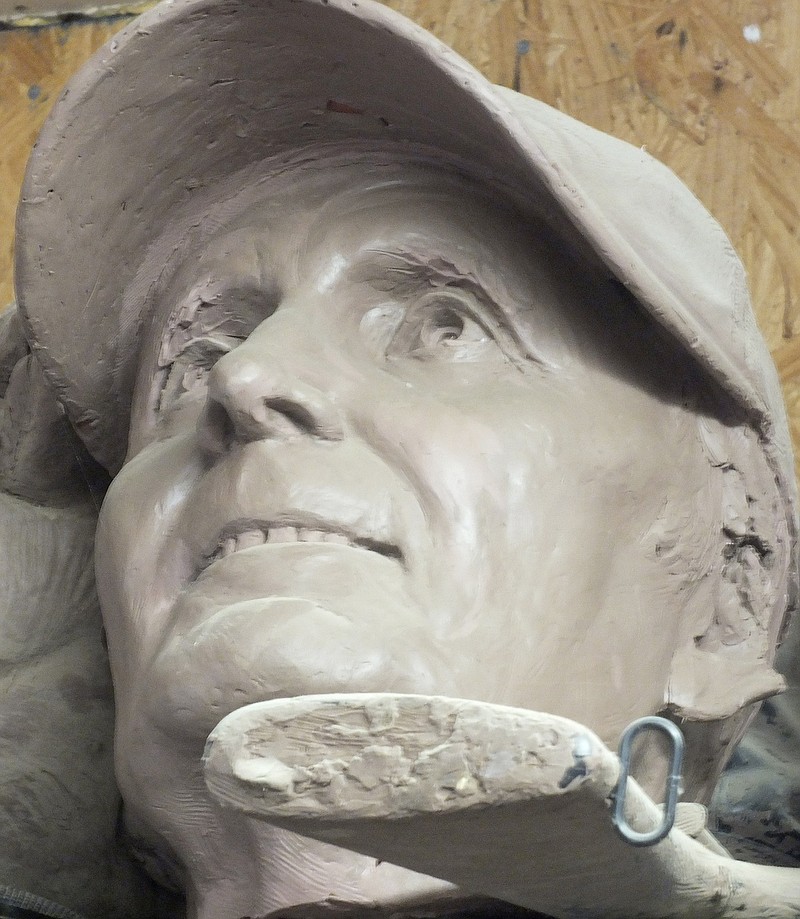Standing beside the newly-designed entrance to John McDonnell field is a seven-foot-tall bronze statue of John McDonnell.
The artist who created that statue, Raymond Gibby, calls Pea Ridge his home.
Over several months and repeated visits with the legendary coach, Gibby painstakingly sculpted a life-size-and-a-quarter replica of McDonnell.
His bronze sculpture of Brandon Burlsworth for the University of Arkansas garnered the attention of Seth Summerside, former track star for the University of Arkansas, and started the process that would result in the bronze statue of McDonnell for John McDonnell Field, the outdoor track facility at the University of Arkansas.
The artist was approached almost five years ago about the statue of McDonnell.
"The most interesting thing I found in doing the statue was just getting to know John. I was very, very happy to become acquaintances because he and his wife are amazing people," Gibby said.
McDonnell, former head coach, ended his 36-year collegiate head coaching career as the most successful coach in NCAA track history. He attained a total of 42 NCAA Championships in three different sports with the Razorbacks.
Gibby moved to northwest Arkansas 14 years ago. He, his wife Aimee and their seven children live in Pea Ridge. He learned his trade in California and Utah working with other artists, he said.
Gibby's foundry and studio are on land behind his parents' home in Garfield. His father, Raymond Wayne Gibby, 80, cuts and prepares all the wood work for his creations -- wooden bases for the bronze statues.
"I did the Brandon Burlsworth trophy a few years ago for Greater Productions," Gibby said, explaining that he was commissioned for that piece. He said a Razorbacks alumni group raised the money for the McDonnell statue.
"I had John (McDonnell) come up here several times. I went to his home and took pictures of everything -- his feet, the top of this head, his hands. He was very gracious," Gibby said.
"His wife was right there with him," the senior Gibby said.
"She was my best art critic," the younger Gibby said, adding that when she would point out specifics about the mold of her husband, and ask her husband, he would say: "I don't know. I barely look in the mirror."
Gibby smiled as he recalled the "criticisms" from the McDonnells. "They would come back with more criticisms, but to soften the blow, would bring signed memorabilia -- a signed hat or poster. Then, they'd take me out to lunch."
The bronze McDonnell statue is done in the "traditional lost wax process," Gibby explained, showing the step-by-step process. He noted that the statue is hollow. It's made from the inside out; first, he welds together a steel armature; then builds out with foam; then carves back the foam to "like the muscles"; and then builds up beyond that -- clay, rubber, plaster, then wax, then ceramic, then bronze, then sanding.
When he worked at an art foundry in California, Gibby said he would spent eight hours a day working on pieces for the foundry, then he's work an additional four hours a day on his own pieces.
"Become most expert at what you're best at," he said, "then follow that with a relentless passion. If it's something you really love, it's not like work."
"I think a lot of artists who are very talented fall short because they don't realize the work that's involved," he said, comparing his career choice to that of his brother, who is a lawyer. "I've studied my craft a lot longer. I need to treat it that way, as any other type of professional."
"I was both happy and sad to have the project done because now he won't come visit very often," Gibby said.
The biggest problem in creating the statue? It was in the lack of space in the small studio. "I sculpted it right there. There's not enough room to stand back and look at it.
Gibby said he was told at a community college in Oregon not to pursue a career in art, that nobody makes it as a fine artist. "'Don't bother,' they told me," he said.
"Whatever a person is best at, is what they should do in my opinion.
"I'm not inclined to a lot of things. This is what I'm inclined to and what I'm best at."
Business on 11/26/2014
